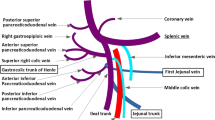Summary
The anatomy of the pancreatic veins has become the object of renewed interest due to the advent of pancreatic phlebography coupled with selective blood sampling to diagnose the site of endocrine tumors of this organ.
This study, based on the examination of 50 postmortem glands prepared by the technique of injection-corrosion, was undertaken to identify the veins of the pancreas and establish anatomicosurgical correlations.
The right pancreas is drained by four relatively constant veins of unequal importance. The two superior pancreaticoduodenal veins (posterosuperior and anterosuperior) join with the portal vein and gastrocolic venous trunk. Due to their large drainage territory these veins are the main routes of cephalic pancreatic venous return. The inferior pancreaticoduodenal veins (posteroinferior and anteroinferior) most often run into the jejunal veins and less frequently end in the superior mesenteric vein.
A part of the right pancreas can be referred to as the retrovenous segment. Drainage of this territory is via the anteroinferior and both posterior pancreaticoduodenal veins as well as by one or two small veins (veins of the retrovenous pancreas) which merge with the posterior surface of the superior mesenteric vein.
The left part of the pancreas is drained by numerous small venous tributaries of the vena lienalis. A second drainage axis, present in half of the cases studied, is the inferior pancreatic vein. The left gastric, inferior mesenteric and middle colic veins afford an accessory route of drainage of the left pancreas.
The anatomical and surgical junction between the right and left parts of the pancreas can be referred to as the prevenous segment. The drainage of this segment is most often via the neighboring veins, although in some cases may be via true isthmic veins, which join the anterior surface of the mesentericoportal trunk.
A protocol for the phlebographic exploration of the pancreas is proposed, based on these anatomical findings. Taking multiple selective samples of venous blood for hormone determinations should allow reduction of the error of tumor localization related to the rich network of venous anastomoses in the pancreas.
Résumé
L'anatomie des veines du pancréas bénéficie d'un regain d'intérêt depuis que la phlébographie pancréatique avec prélèvements sanguins sélectifs est venue enrichir les moyens de localisation des tumeurs endocrines du pancréas. Basée sur l'étude de 50 pièces d'injection-corrosion, leur description permet de retrouver la dualité anatomochirurgicale de la glande.
Le pancréas droit est drainé par 4 veines relativement constantes mais dont l'importance est inégale. Les veines pancréatico-duodénales supérieures (PDPS et PDAS) rejoignent la veine porte et le système du tronc gastrocolique; par l'étendue de leur territoire de drainage, elles représentent les pédicules céphaliques principaux. Les veines pancréatico-duodénales inférieures (PDPI et PDAI) gagnent le plus souvent les veines jéjunales et s'abouchent plus rarement dans la veine mésentérique supérieure.
Le pancréas rétro-veineux fait partie du pancréas droit; son drainage est assuré non seulement par les veines pancréatico-duodénales postérieures et la veine pancréatico-duodénale antéro-inférieure mais aussi par une ou deux petites veines implantées à la face postérieure de la veine mésentérique supérieure (veine du pancréas rétro-veineux).
La pancréas gauche est drainé par un grand nombre de petites veines qui gagnent la face antérieure de la veine liénale. La veine pancréatique inférieure existe dans la moitié des cas et représente alors le second axe de son drainage. Plus accessoire ment, les veines gastriques gauches, la veine mésentérique inférieure et la veine colique moyenne peuvent y prendre part.
Le pancréas pré-veineux représente la charnière anatomique et chirurgicale entre ces deux ensembles; son drainage emprunte le plus souvent les veines adjacentes mais il est parfois aussi assuré par des veines isthmiques propres qui gagnent la face antérieure du tronc mésentérico-portal.
A l'issue de cette description, un protocole d'exploration phlébographique est proposé. La multiplication des dosages hormonaux sélectifs doit permettre de déjouer les erreurs de localisation tumorale liées aux riches connections anastomotiques des veines du pancréas.
Similar content being viewed by others
References
Calas F, Bouchet Y, Martin R, Couppie G (1956) Les veines du pancréas. 43ème Réunion de l'Association des Anatomistes, Lisbonne
Calas F, Bouchet Y, Martin R, Couppie G (1958) Segment rétro-veineux de la tête du pancréas. Bull Assoc Anat 98:211–217
Calas F, Couppie G, Martin R, Bouchet Y (1959) Etude des affluents et de la formation de la veine porte. Bull Assoc Anat 99:254–271
Delattre JF (1979) Etude anatomique de la veine mésentérique supérieure. A propos de 45 dissections. Applications chirurgicales. Thèse, Reims 1979
Descomps P, Lalaubie G (1912) Les veines mésentériques. J Anat Physiol 48:337–376
Douglass BE, Baggenstoss AH, Hollinschead WH (1950) The anatomy of the portal vein and its tributaries. Surg Gynecol Obstet 91:562–576
Falconer CWA, Griffiths E (1950) The anatomy of the blood-vessels in the region of the pancreas. Br J Surg 37:334–344
Gillot C, Hureau J, Aaron C, Martini R, Thaler G, Michels N (1964) The superior mesenteric vein. An anatomic and surgical study of eighty-one subjects. J Int Coll Surg 41:339–369
Gillot C, Hureau J, Aaron C, Martini R (1962) La veine mésentérique supérieure. Mémoire du Laboratoire d'Anatomie, Faculté de Médecine, Paris
Kirk E (1932) Untersuchungen über die gröbere und feinere topographische Verteilung der Arterien, Venen und Ausführungsgänge in der menschlichen Bauchspeicheldrüse. Z Ges Anat 94:822–875
Gothlin A, Lunderquist A, Tylen U (1974) Selective phlebography of the pancreas. Acta Radiol [Diagn] (Stockh) 15:474–480
Reichardt W, Cameron R (1980) Anatomy of the pancreatic veins. A post mortem and clinical phlebographic investigation. Acta Radiol [Diagn] (Stockh) 21:33–41
Roche A, Pennec JM, Raisonnier A, Doyon D (1979) L'exploration angiographique des tumeurs endocrines du pancréas: artériographie et phlébographie. J Chir 116:567–572
Serres JJ, Butori PJ, Richelme H, Patouraux Cl (1980) Ponction transparieto-hépatique du système porte avec repérage échographique. Nouv Presse Med 9:2569–2571
Author information
Authors and Affiliations
Rights and permissions
About this article
Cite this article
Birtwisle, Y., Ferrari, C., Bourgeon, A. et al. Venous drainage of the pancreas and its relations to pancreatic phlebography. Anat. Clin 5, 103–113 (1983). https://doi.org/10.1007/BF01798981
Issue Date:
DOI: https://doi.org/10.1007/BF01798981




